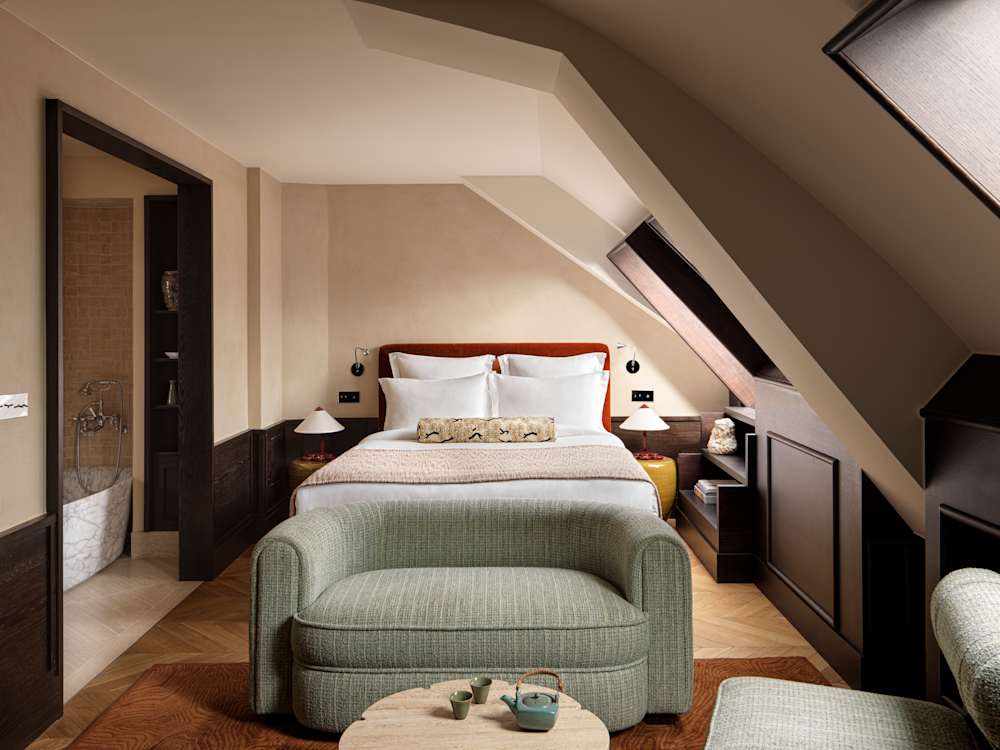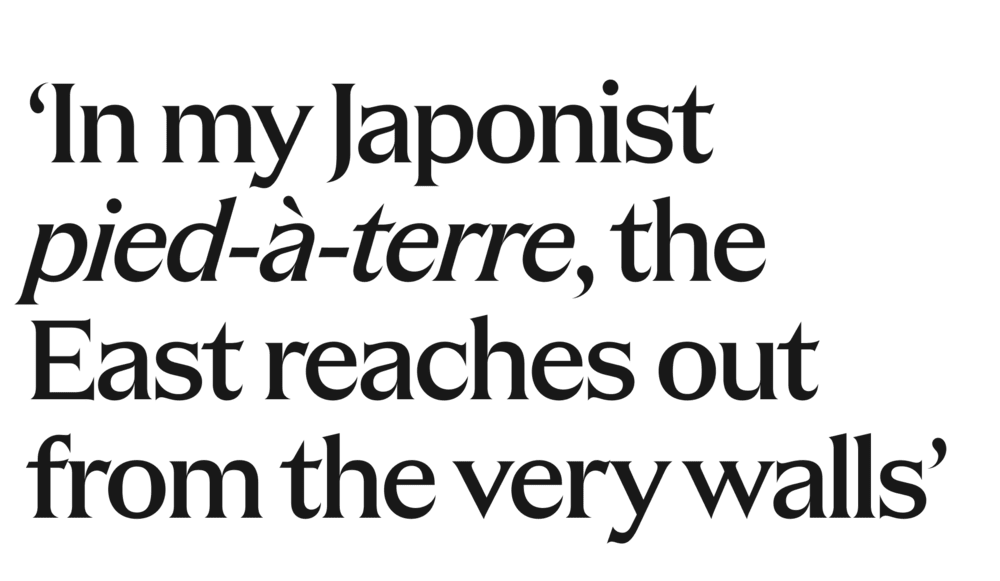On 8 July 1853, an American commodore named Matthew C. Perry sailed into Edo Bay with 500 males, 73 cannons and one sternly-worded letter. The world was by no means fairly the identical once more. For this second would come to be generally known as the ‘Opening of Japan’, the primary time a commerce treaty was struck between Westerners and the Japanese for 220 years. Unable to rebuff Perry’s gunboat diplomacy, the shogunate signed, bringing Japan’s isolationist coverage of sakoku (‘chained nation’) to an finish. The floodgates had been about to open, clearing the way in which for a fantastic wave of cultural trade that will alter Western artwork and aesthetics ceaselessly.

172 years later, I’ve come to Paris to hunt out the legacy of this cultural revolution. Crusing up the Rue du 4 Septembre within the dead-central Deuxième, I shut in on my prize: the district generally known as Little Tokyo, centred across the Rue Sainte-Anne. My port? The Hôtel Hana, a up to date Parisian keep that marries the imperial fashion of Haussmann — Paris’ precept city-shaper — with the softer, wabi-sabi ideas you’d discover in Japanese machiya (townhouses) or ryokans (conventional inns).
However why Paris particularly? After Perry’s expedition, Japanese objects and concepts poured into Europe, sparking a craze that got here to be generally known as Japonisme — which is apt, as a result of it was the French that carried the obsession to fever pitch. On the 1878 Paris Exposition Universelle, there was such a rush to purchase Japonist gadgets that the truthful bought out within the first few weeks (keep in mind it had a six-month runtime). In Montmartre, Claude Monet and Edgar Degas had been busy modifying their Impressionist types based mostly on Japanese aesthetics, whereas Vincent van Gogh was accumulating ukiyo-e woodblock prints and displaying them on the Café du Tambourin. The hook was nicely and really in.

Within the meantime, my very own immersion has begun. I’ve arrived, having spied a good-looking entrance door with brass handles formed like bamboo stems. The title ‘Hana’ means ‘flower’, and the second you cross the brink, the ideas of Japanese design start to blossom forth. French designer Laura Gonzalez is behind the interiors right here and it’s her use of wooden that strikes you first: it covers the partitions, the ceiling and the curving architraves connecting the foyer, bar and restaurant. It’s all fantastically formed however there’s no paint, polish or ornamental engraving on present; as an alternative, the grain does the speaking. This celebration of pure supplies nonetheless feels trendy in the present day however it was a revelation in Nineteenth-century Europe.
Chinese language artwork had made its strategy to France a lot earlier, however its lavish ornamentation and sophisticated patterns weren’t all that far faraway from modern types like Rococo or Baroque. Wabi-sabi, the Japanese embrace of simplicity and imperfection, was one thing new. As if to drive this house, the tables in restaurant Hanabi are topped with a thick layer of raku ceramic, glazed in a mossy inexperienced. The seams becoming a member of the pottery are there for all to see, as are patinas of cracks and tiny air bubbles that guarantee no two are alike. That is all intentional in fact, as are the painterly splashes on the restaurant’s steel murals, harking back to the calligraphy strokes utilized in kanji. However there’s a laissez-faire angle that governs the entire.
Upstairs in my Japonist pied-à-terre, the East reaches out from the very partitions, partitioned with slats of wooden and clad in tightly-woven straw. This papery floor is lit by lamps masquerading as half-moons, an ode to the lanterns discovered on the streets of Kyoto. On a espresso desk formed like a cherry blossom is a plate of muffins — one inexperienced, one black — which turn into flavoured with matcha and sesame seed, rendered in gloriously dense pâtisserie. That is my first style of Hanabi’s Japanese-inspired delicacies and succeeds in carrying my ideas straight to the Land of the Rising Solar, as if known as by the melody of a shamisen lute. Visions of sake and scorching wagyu fill the thoughts. Alas, my dinner reservation will not be for one more two hours, so I accept a yuzu sencha tea and a few buckwheat chocolate from the minibar, then head out into the afternoon solar.

I’ll admit I’d by no means been to Little Tokyo earlier than this journey. And I’m glad, as a result of this pleased hang-out turned my house for a lot of the following 24 hours. It’s a wonderful little quartier to walk round, stuffed with stylishly dressed Japanese and Koreans. It’s the place you’ll discover the town’s finest ramen spots (strive Kodawari Tsukiji, famed for its sea-bream broths and styled like an eatery you’d discover down a Tokyo alleyway); sushi eating places (Sushi B, with simply eight seats on the counter, is a favorite); in addition to Asian supermarkets, ceramic shops and boutiques. There are limitless methods to spoil your urge for food, together with delectable miso fondants by Emiko Sano, chocolatier at Le Trois Chocolats. However I can’t get up Hanabi, so I fall on my sword, sticking with only a taster.
Again on the lodge, the stage is about. First, a Hatozaki whisky cocktail, muddled with a mix of Japanese spices, home made vanilla syrup and a smoky infusion made with rice and the wooden of a cherry tree. It’s the type of drink you’d by no means know to ask for however seems to be exactly what you needed. My solely criticism is that it’s drained all too quickly — so I search solace in the truth that fleeting pleasures had been a core aspect of ukiyo (the ‘floating world’), an Edo-era philosophy that fascinated French artists like Pierre-Auguste Renoir, who sought to reinterpret its embrace of impermanence and transient moments.
Resolved to stay within the now, I flip to my starter, a complete courgette flower, flash-fried tempura fashion and sprayed with a wonderful mist of vinegar, sake and miso. Then comes the yellowtail sashimi, organized in little swimming pools of oil that convey new flavours with every chunk: herb, spice, citrus… The grand finale is a complete fish grilled over Japanese binchō-tan — seemingly the purest charcoal on earth — and served with a kumquat salad and citrussy yuzushu mayo. It’s wonderful, each dish, and composed with as a lot artistry as a print by Hokusai. By the tip, all that’s left to do is float upstairs to mattress.

The subsequent morning, I’m going looking for the supply of the Japonist infatuation. You’ll discover solutions on the Musée Cernuschi, a grand mansion on the sting of the Parc Monceau. After taking the mom of all gap-years, rich politician Henri Cernuschi had amassed one of many largest non-public collections of Asian artwork in Europe, sending house 900 crates stuffed with monumental bronzes, ceramics, lacquered wooden, prints and work. Then there’s the Musée Guimet, the place you start on the bottom ground among the many most historical Asian relics, working your approach up till you get to the ultimate piece within the collector’s puzzle: Japan. Between the 2, the impact of Japanese tradition on European sensibilities begins to turn out to be clear. Artwork was not simply portray and sculpture, it could possibly be a teapot, a bowl or a woodblock print. Perspective and stability had been important, understatement was lovely, and transience was one thing to be celebrated, not feared. And that’s exactly what Hôtel Hana is all about: embracing the wonder in all issues and savouring these fleeting moments.
Plot your personal Japonist path with our full Paris assortment or head to the supply in Japan



